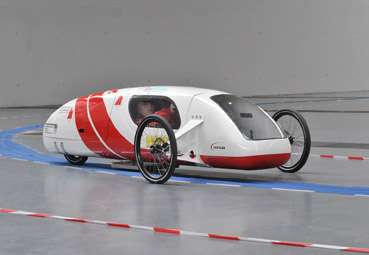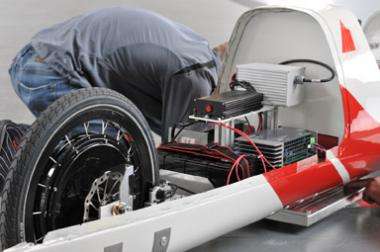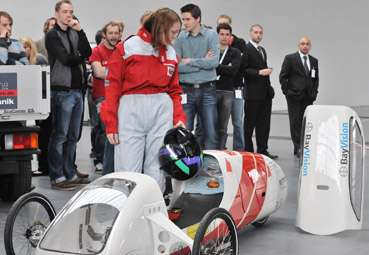September 14, 2010 report
Demonstration electric car draws energy from the road

(PhysOrg.com) -- Students in Germany have built the "E-Quickie," a three-wheeled electric car that draws energy wirelessly from electric conducting paths on the ground.
New wireless charging technologies are appearing regularly these days, such as a wireless charging mat for charging electric cars while they are parked (see the PhysOrg article), but the new car takes its energy wirelessly from the road.
Mechanical engineering and mechatronics students from the Karlsruhe University of Applied Sciences (HsKA) built the experimental car to test the practicality of the wireless technology. The car is propelled by an electrical hub drive, with energy drawn from conducting tracks on the ground via electrical induction. The receivers are fitted to the underside of the car, and there are small onboard batteries, which serve as a buffer for times when the car leaves the electrical conductor tracks.
The conducting track was supplied by the company SEW-Eurodrive, based in Bruchsal. The components of the car were designed and built by the 14 students using carbon fiber for the vehicle body and high-tech materials for the chassis and braking and steering systems. The design was fully tested and optimized by computer in a “virtual wind channel” before the car was actually built.

The car resembles a reclining bicycle with the driver inside a capsule. It weighs only 60 kg, but the team hopes to reduce the weight to 40 kg in future. Head of the project, Professor Jürgen Walter, of the Mechanical Engineering and Mechatronics faculty at the university, said the team were aiming for a driver:vehicle weight ratio of 2:1, while for most vehicles the ratio is between 1:10 and 1:15.
The lightweight design means the car can reach 50 km/h, even with its 2 kW motor. The car has successfully completed 40 laps on a 222-meter-long conductor track at the university, and the team plans to continue using the track to optimize the E-Quickie. They are also planning test drives from the university to the nearby castle and another university campus in the town.
Professor Walter said the principle used by the car is not really new, but it could be used much more widely than it is at present. Industry could operate internal transport vehicles in this way for example, he said, but the students also wanted to demonstrate that wireless transfer of energy is also suitable for mass transit applications.

More information: Karlsruhe University of Applied Sciences: www.hs-karlsruhe.de/servlet/PB … html?pbanker=car#car
© 2010 PhysOrg.com



















